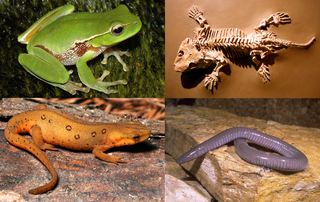Frogs and toads
There are 17 species of frogs and toads in Iowa. [1]
The following is a list of amphibians that are known to inhabit the US State of Iowa . The list includes frogs, toads, and salamanders.
There are 17 species of frogs and toads in Iowa. [1]
There are 5 species of salamanders in Iowa. [1]
| Common name | Scientific name | Status in Iowa | Picture |
|---|---|---|---|
| Blue-spotted salamander | Ambystoma laterale | Endangered |  |
| Central newt | Notophthalmus viridescens louisianensis | Threatened |  |
| Common mudpuppy | Necturus maculosus | Threatened |  |
| Small-mouth salamander | Ambystoma texanum |  | |
| Tiger salamander | Ambystoma tigrinum |  |

Amphibians are ectothermic, tetrapod vertebrates of the class Amphibia. All living amphibians belong to the group Lissamphibia. They inhabit a wide variety of habitats, with most species living within terrestrial, fossorial, arboreal or freshwater aquatic ecosystems. Thus amphibians typically start out as larvae living in water, but some species have developed behavioural adaptations to bypass this.

The fauna of Canada consist of approximately 200 mammal species, over 460 native bird species, 43 amphibian species, 43 reptile species, and 1,200 fish species. The biology survey of Canada cites that there are approximately 55,000 species of insects, and 11,000 species of mites and spiders.

The Ezo salamander or Hokkaido salamander is a species of salamander in the family Hynobiidae, endemic to Japan. Its natural habitats are temperate forests, temperate shrubland, swamps, freshwater marshes, intermittent freshwater marshes, freshwater springs, irrigated land, and canals and ditches.

Poisonous amphibians are amphibians that produce toxins to defend themselves from predators.